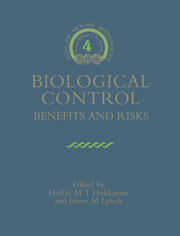Book contents
- Frontmatter
- Contents
- List of Contributors
- Series Preface
- Preface: Overview of Benefits and Risks of Biological Control Introductions
- Part I Biological Invasions
- 1 Suppressiveness of Soils to Invading Micro-organisms
- 2 Biotechnology: Environmental Impacts of Introducing Crops and Biocontrol Agents in North American Agriculture
- 3 Frequency and Consequences of Insect Invasions
- 4 Integrated Pest Management (IPM) in Fruit Orchards
- Part II Classical Biocontrol
- Part III Augmentative Biocontrol
- Part IV Use of Genetically Modified Organisms
- Part V Economics and Registration
- Index
3 - Frequency and Consequences of Insect Invasions
Published online by Cambridge University Press: 07 May 2010
- Frontmatter
- Contents
- List of Contributors
- Series Preface
- Preface: Overview of Benefits and Risks of Biological Control Introductions
- Part I Biological Invasions
- 1 Suppressiveness of Soils to Invading Micro-organisms
- 2 Biotechnology: Environmental Impacts of Introducing Crops and Biocontrol Agents in North American Agriculture
- 3 Frequency and Consequences of Insect Invasions
- 4 Integrated Pest Management (IPM) in Fruit Orchards
- Part II Classical Biocontrol
- Part III Augmentative Biocontrol
- Part IV Use of Genetically Modified Organisms
- Part V Economics and Registration
- Index
Summary
Introduction
A species is described as an invader when it colonizes and persists in an ecosystem in which it has never been before (Mooney and Drake, 1989). Invasions by insects seem to be rather well documented, but that is a false impression. It is only for two categories of insect species that documentation of successful invasions is complete: (i) for pest species (usually herbivores); and (it) for natural enemies (predators and parasitoids of insect pests, or phytophagous insects used in weed control). This information relates mainly to agro-ecosystems and few or no data are available for insect invasions in other ecosystems. This might mean that such ecosystems are not frequently invaded, that the effect of invaders is not dramatic (but see Howarth, 1991; also, see Hopper, Chapter 6 and Andow et al, Chapter 10), or that these other ecosystems are considered economically so unimportant that they receive no attention. The first view seems to be supported by the general literature on colonization, where the massive restructuring of natural ecosystems is usually regarded as the main cause for making invasions possible. Complex natural systems are replaced by a few plants and animals that are of direct use to humans (Mooney and Drake, 1986a).
This paper is structured as follows: first, some general facts about insect invasions are stated and then several case studies are provided to illustrate problems created by insect invasions. Following this the characteristics of the insect invaders and the systems which are invaded are discussed. Finally, some specific questions related to the predictability of the effects of insect invasions are answered.
- Type
- Chapter
- Information
- Biological ControlBenefits and Risks, pp. 30 - 43Publisher: Cambridge University PressPrint publication year: 1995
- 4
- Cited by



